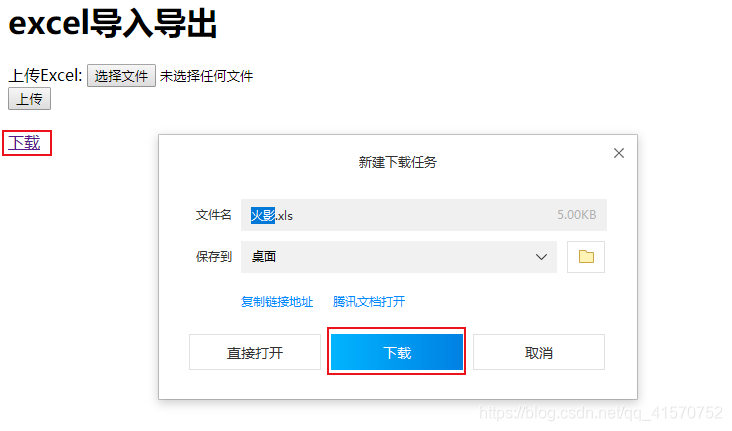pompón
Además del iniciador de escena necesario (iniciador) del proyecto springboot, el pom también debe agregar las siguientes dependencias, esaypoi.
Preste atención a la versión de easypoi, el blogger 3.2.0 que se usaba antes, siempre informaba de un error al iniciar, y reconstruía un proyecto y lo reemplazaba con una versión inferior para que se ejecutara correctamente.
<dependency>
<groupId>cn.afterturn</groupId>
<artifactId>easypoi-base</artifactId>
<version>3.0.1</version>
</dependency>
<dependency>
<groupId>cn.afterturn</groupId>
<artifactId>easypoi-web</artifactId>
<version>3.0.1</version>
</dependency>
<dependency>
<groupId>cn.afterturn</groupId>
<artifactId>easypoi-annotation</artifactId>
<version>3.0.1</version>
</dependency>
Controlador
@GetMapping("/export")
public void export(HttpServletResponse response){
//模拟从数据库获取需要导出的数据
List<Person> personList = new ArrayList<>();
Person person1 = new Person("柱间","1",new Date());
Person person2 = new Person("小南","2", new Date());
Person person3 = new Person("鼬","1", new Date());
Person person4 = new Person("萨斯给","1",new Date());
personList.add(person1);
personList.add(person2);
personList.add(person3);
personList.add(person4);
//导出操作
ExcelUtil.exportExcel(personList,"报名表","忍者",Person.class,"火影.xls",response);
}
@PostMapping("/importExcel")
public void importExcel(MultipartFile file){
String filePath = "D:\\火影.xls";
//解析excel,
// 方式一:根据文件路径解析
// List<Person> personList = ExcelUtil.importExcel(filePath,1,1,Person.class);
// 方式二:也可以使用MultipartFile,使用 FileUtil.importExcel(MultipartFile file, Integer titleRows, Integer headerRows, Class<T> pojoClass)导入
List<Person> personList = ExcelUtil.importExcel(file, 1, 1, Person.class);
System.out.println("导入数据一共【"+personList.size()+"】行");
//TODO 保存数据库
System.out.println(personList);
}
frijol
public class Person {
@Excel(name = "姓名", orderNum = "0")
private String name;
@Excel(name = "性别", replace = {
"男_1", "女_2"}, orderNum = "1")
private String sex;
@Excel(name = "生日", exportFormat = "yyyy-MM-dd", orderNum = "2")
private Date birthday;
public Person() {
}
getter setter略...
Instrumentos
import cn.afterturn.easypoi.excel.ExcelExportUtil;
import cn.afterturn.easypoi.excel.ExcelImportUtil;
import cn.afterturn.easypoi.excel.entity.ExportParams;
import cn.afterturn.easypoi.excel.entity.ImportParams;
import cn.afterturn.easypoi.excel.entity.enmus.ExcelType;
import org.apache.commons.lang3.StringUtils;
import org.apache.poi.ss.usermodel.Workbook;
import org.springframework.web.multipart.MultipartFile;
import javax.servlet.http.HttpServletResponse;
import java.io.File;
import java.io.IOException;
import java.net.URLEncoder;
import java.util.List;
import java.util.Map;
import java.util.NoSuchElementException;
public class ExcelUtil {
public static void exportExcel(List<?> list, String title, String sheetName, Class<?> pojoClass, String fileName, boolean isCreateHeader, HttpServletResponse response){
ExportParams exportParams = new ExportParams(title, sheetName);
exportParams.setCreateHeadRows(isCreateHeader);
defaultExport(list, pojoClass, fileName, response, exportParams);
}
public static void exportExcel(List<?> list, String title, String sheetName, Class<?> pojoClass,String fileName, HttpServletResponse response){
defaultExport(list, pojoClass, fileName, response, new ExportParams(title, sheetName));
}
public static void exportExcel(List<Map<String, Object>> list, String fileName, HttpServletResponse response){
defaultExport(list, fileName, response);
}
private static void defaultExport(List<?> list, Class<?> pojoClass, String fileName, HttpServletResponse response, ExportParams exportParams) {
Workbook workbook = ExcelExportUtil.exportExcel(exportParams,pojoClass,list);
if (workbook != null);
downLoadExcel(fileName, response, workbook);
}
private static void downLoadExcel(String fileName, HttpServletResponse response, Workbook workbook) {
try {
response.setCharacterEncoding("UTF-8");
response.setHeader("content-Type", "application/vnd.ms-excel");
response.setHeader("Content-Disposition",
"attachment;filename=" + URLEncoder.encode(fileName, "UTF-8"));
workbook.write(response.getOutputStream());
} catch (IOException e) {
throw new RuntimeException(e.getMessage());
}
}
private static void defaultExport(List<Map<String, Object>> list, String fileName, HttpServletResponse response) {
Workbook workbook = ExcelExportUtil.exportExcel(list, ExcelType.HSSF);
if (workbook != null);
downLoadExcel(fileName, response, workbook);
}
public static <T> List<T> importExcel(String filePath,Integer titleRows,Integer headerRows, Class<T> pojoClass){
if (StringUtils.isBlank(filePath)){
return null;
}
ImportParams params = new ImportParams();
params.setTitleRows(titleRows);
params.setHeadRows(headerRows);
List<T> list = null;
try {
list = ExcelImportUtil.importExcel(new File(filePath), pojoClass, params);
}catch (NoSuchElementException e){
throw new RuntimeException("模板不能为空");
} catch (Exception e) {
e.printStackTrace();
throw new RuntimeException(e.getMessage());
}
return list;
}
public static <T> List<T> importExcel(MultipartFile file, Integer titleRows, Integer headerRows, Class<T> pojoClass){
if (file == null){
return null;
}
ImportParams params = new ImportParams();
params.setTitleRows(titleRows);
params.setHeadRows(headerRows);
List<T> list = null;
try {
list = ExcelImportUtil.importExcel(file.getInputStream(), pojoClass, params);
}catch (NoSuchElementException e){
throw new RuntimeException("excel文件不能为空");
} catch (Exception e) {
throw new RuntimeException(e.getMessage());
}
return list;
}
}
código de front-end
<div id="center">
<form method="post" action="/importExcel" enctype="multipart/form-data">
上传Excel: <input type="file" name="file"/>
<br />
<button>上传</button>
</form>
<br />
<a href="/export">下载</a>
</div>
prueba
descargar

subir

información de impresión de la consola

Resumir
Al usar easypoi, las operaciones de carga, descarga y análisis de archivos de Excel se realizan fácilmente. El código anterior es solo una demostración simple. En escenarios comerciales específicos, es necesario agregar algún trabajo de verificación de seguridad y los archivos cargados deben analizarse de acuerdo con a los requisitos del negocio Los datos se guardan en la base de datos.